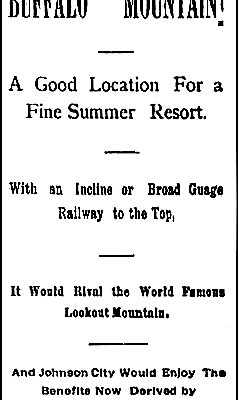Between 1950 and 1957, my family lived on Johnson Avenue, directly behind the playground of Henry Johnson School and within sight of the west end of Kiwanis Park. The view of Buffalo Mountain from our house was always there to enjoy.
An even better observation of the noble mountain came from the kitchen on the backside of the house of my grandparent's, Earl and Neva Cox, that was located on Peachtree Street, four streets behind us.
Even as a child, I appreciated its ever-changing appearance as the seasons evolved from spring to summer to autumn to winter and back to spring. We always knew when snow was about to arrive in Johnson City because the mountain would slowly turn color as the pretty white stuff fell.
My father, Robert Earl Cox, often told me stories about day-long hikes to White Rock on the mountain along the south end of the city. Several of my readers shared their fond memories of the popular hike there for my column.
Buffalo Mountain is a part of the Cherokee National Forest within the Appalachian Mountains, stretching from Johnson City east to west for about seven miles to Jonesborough.
I always thought the mountain acquired its name from the humps on it that resemble a buffalo. Actually, most mountains have humps. According to my research from the Tipton Haynes Historical Association, buffalo herds used the base of this mountain as a gathering spot as they made a twice-a-year pilgrimage to the salt licks of Saltville, Virginia. As the buffalo herds moved along, they cleared out five-foot wide trails that became so hard they appeared to be paved. These paths later became some of the first roads in the area.

Buffalo Mountain Article Title & Subtitles From The Comet In 1892
Recently, I located an interesting November 1892 clipping from The Comet. The article suggested that Johnson City would be an ideal location for a summer resort or a large sanitarium for the treatment of pulmonary diseases. Reputable physicians from across the country recommended the climate of East Tennessee for such ailments. Many persons had already traveled here and had greatly benefited from the refreshing excursion.
The trekkers looked like skeletons when they arrived in the city but gained several pounds in a relatively short time. In instances where they remained here for extended amounts of times, they were completely and permanently cured. The word spread.
The Comet felt that there could be no better place to locate a hotel or sanitarium than atop Buffalo Mountain, which then was then located three miles south of the city.
Standing on top of the magnificent mountain, with an elevation of several hundred feet, one gets an elegant and entertaining view of the surrounding country, which is only equaled by the famous Lookout Mountain in Chattanooga.
Standing at a point on the top of the mountain, one can peer into three additional states: Virginia, North Carolina and Kentucky. At night, the electric lights of Morristown, Greeneville and Bristol are in plain view.
The Comet suggested that a large hotel on top of the mountain and the broad gauge of an incline railway to transport passengers to the top was highly practical. This would allow Johnson City to reap some of the many benefits enjoyed by Tate Springs (Bean Station), Chattanooga, Roan Mountain and many other noted places.
“This is a scheme that has been in contemplation for some time,” said the newspaper, “and no doubt will be carried out at no distant day, as several capitalists have examined the location with a view of purchasing it and carrying out the above mentioned plans. Should this ever be done, which is more than probable that it will, it would bring thousands of dollars into this city annually, to say nothing of the many noted visitors and pleasure seekers.”
Situated as we are, right in the midst of this beautiful and healthful East Tennessee, the publication could not fail to see immediately the benefits to be derived from such a place as mentioned.
